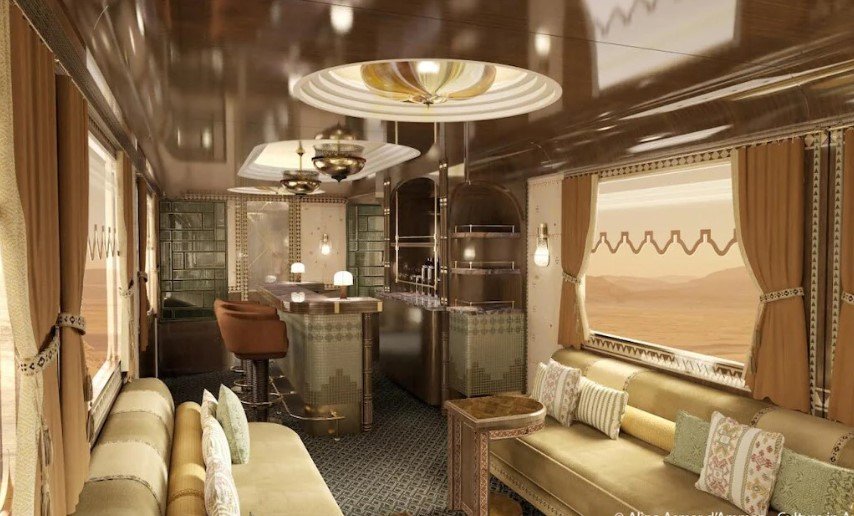Saudi Arabia and the UAE are rolling out new luxury train services that promise to transform travel in the Middle East. With Saudi Arabia’s Dream of the Desert set for a 2026 launch and the UAE’s Etihad Rail luxury line planned for 2028, these projects aim to blend high-end comfort with stunning desert views, drawing global tourists seeking unique experiences.
Revival of Rail Luxury in the Gulf
Luxury train travel is making a strong comeback worldwide, and the Gulf region is leading the charge. Experts point to a growing demand for slow, sustainable journeys that let passengers unplug and enjoy the scenery. In Saudi Arabia, the Dream of the Desert project stands out as the kingdom’s first ultra-luxury train, designed to evoke the golden age of rail while showcasing local heritage.
This surge ties into broader tourism goals under Saudi Vision 2030 and the UAE’s push for diverse travel options. Recent events, like the unveiling of train mock-ups at the Future Investment Initiative in Riyadh, highlight how these initiatives are gaining momentum. Travelers are excited about the mix of modern amenities and cultural touches, such as desert-inspired interiors.
The trend also aligns with global shifts toward eco-friendly travel. Rail offers lower carbon footprints compared to flights, appealing to environmentally conscious visitors. As air travel faces scrutiny over emissions, these trains provide a stylish alternative for exploring the region’s vast landscapes.

Inside Saudi Arabia’s Dream of the Desert
Dream of the Desert will cover 1,300 kilometers from Riyadh to Al Qurayyat near the Jordan border, stopping at key sites like Unesco World Heritage locations. The train, a collaboration between Italian firm Arsenale Group and Saudi Arabia Railways, features 33 private suites, including two presidential ones, for up to 66 guests.
Interiors draw from Saudi culture, with golden accents, carved wood, and hues inspired by the desert and landmarks like AlUla. Passengers can expect fine dining in two restaurant cars and relaxation in a majlis lounge. The journey, lasting one or two nights, promises views of dunes, green oases in Qassim, and Hail’s mountains.
Bookings open by late 2025, with prices ranging from $3,000 to $5,000 per person per night. This positions it in the ultra-luxury segment, similar to Europe’s Orient Express. Recent mock-up reveals at Riyadh’s investment forum have sparked buzz, with designs praised for blending Italian craftsmanship and Saudi traditions.
To give a clear picture of what riders can expect, here are some standout features:
- Suites and Capacity: 33 suites with options for singles, doubles, or presidential luxury, hosting up to 66 people per trip.
- Dining and Lounges: Two cars for gourmet meals using local ingredients, plus a cultural majlis for social gatherings.
- Route Highlights: Stops at historic spots, offering excursions to ancient sites and natural wonders.
UAE’s Etihad Rail Joins the Luxury Wave
The UAE is not far behind, with Etihad Rail planning its luxury service for 2028. This follows the launch of standard passenger trains in 2026, connecting 11 key areas including Abu Dhabi, Dubai, and Fujairah. The luxury version will extend to spots like the Liwa Desert, offering unmatched views of diverse landscapes from coasts to dunes.
Etihad Rail’s project emphasizes seamless travel, with trains reaching speeds up to 200 kilometers per hour. It pays homage to Emirati heritage through design elements, much like its Saudi counterpart. Officials compare the ease of rail travel to flying, aiming to link cities and even extend to Oman in the future.
This initiative supports the UAE’s tourism boom, tying into events like Expo remnants and cultural festivals. Recent announcements highlight how it will provide business and economy seating with Wi-Fi, making it practical for both leisure and work trips.
Comparing the Two Luxury Rail Projects
Both projects share goals of boosting tourism and sustainability, but they differ in scope and timeline. Saudi Arabia’s train focuses on long-haul desert adventures, while the UAE’s emphasizes connectivity within and beyond its borders.
Here’s a quick comparison in table form to help travelers decide:
| Feature | Dream of the Desert (Saudi Arabia) | Etihad Rail Luxury (UAE) |
|---|---|---|
| Launch Year | 2026 | 2028 |
| Route Length | 1,300 km | Over 900 km |
| Key Stops | Riyadh to Al Qurayyat, Unesco sites | Abu Dhabi to Fujairah, Liwa Desert |
| Capacity | Up to 66 guests | Varies by train |
| Price Range | $3,000 to $5,000 per night | Not yet announced |
| Unique Selling Point | Cultural immersion in desert heritage | High-speed links to diverse UAE spots |
These differences make each appealing to different audiences, from history buffs to adventure seekers.
Economic and Cultural Impact
These trains are more than just transport; they drive economic growth. In Saudi Arabia, Dream of the Desert supports Vision 2030 by attracting high-end tourists and creating jobs in hospitality and rail sectors. Similarly, Etihad Rail bolsters the UAE’s economy, with projections of millions in tourism revenue.
Culturally, they preserve and promote heritage. Passengers will experience local cuisine, art, and stories onboard, fostering global appreciation. Recent social media buzz, including posts from travelers and officials, shows growing excitement, with many calling it a game-changer for Middle East tourism.
Experts predict this could inspire more regional rail links, like potential Gulf-wide networks discussed in recent forums.
Challenges and Future Outlook
No major project is without hurdles. Building luxury trains involves high costs, estimated at hundreds of millions, and requires precise engineering for desert conditions. Weather extremes and infrastructure needs pose risks, but partnerships with experienced firms like Arsenale help mitigate them.
Looking ahead, success could lead to expansions, such as international routes. With global interest in sustainable luxury, these trains might set new standards. As of November 2025, preparations are on track, with Saudi mock-ups already impressing investors.
If you’re planning a trip, these developments offer fresh ways to explore the Gulf. Share your thoughts in the comments below or spread the word to fellow travel enthusiasts.
